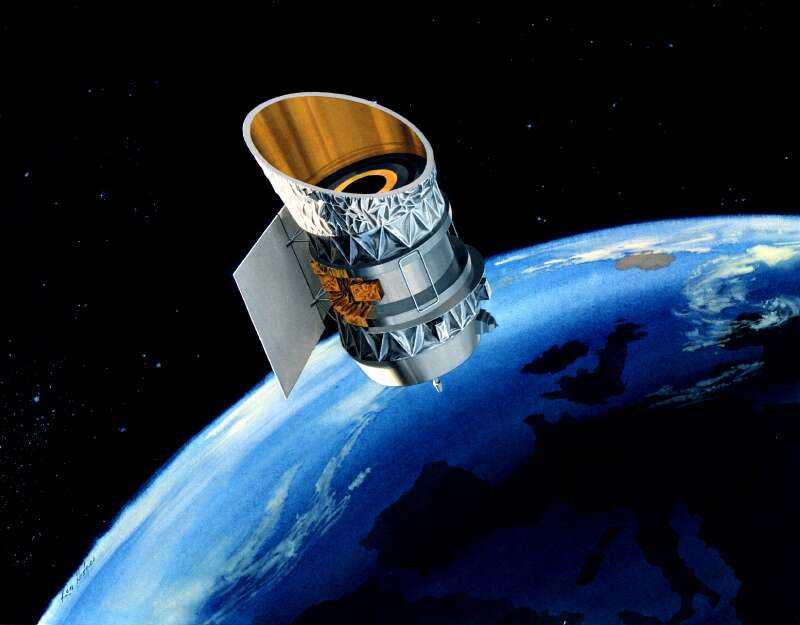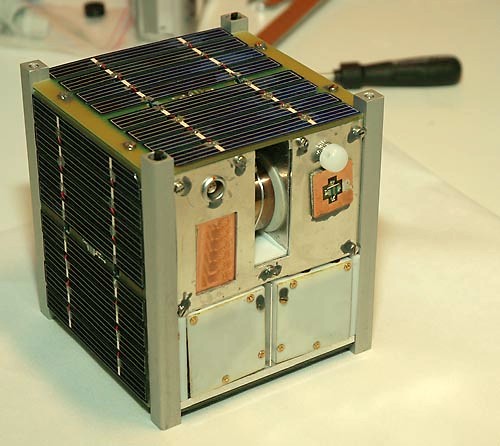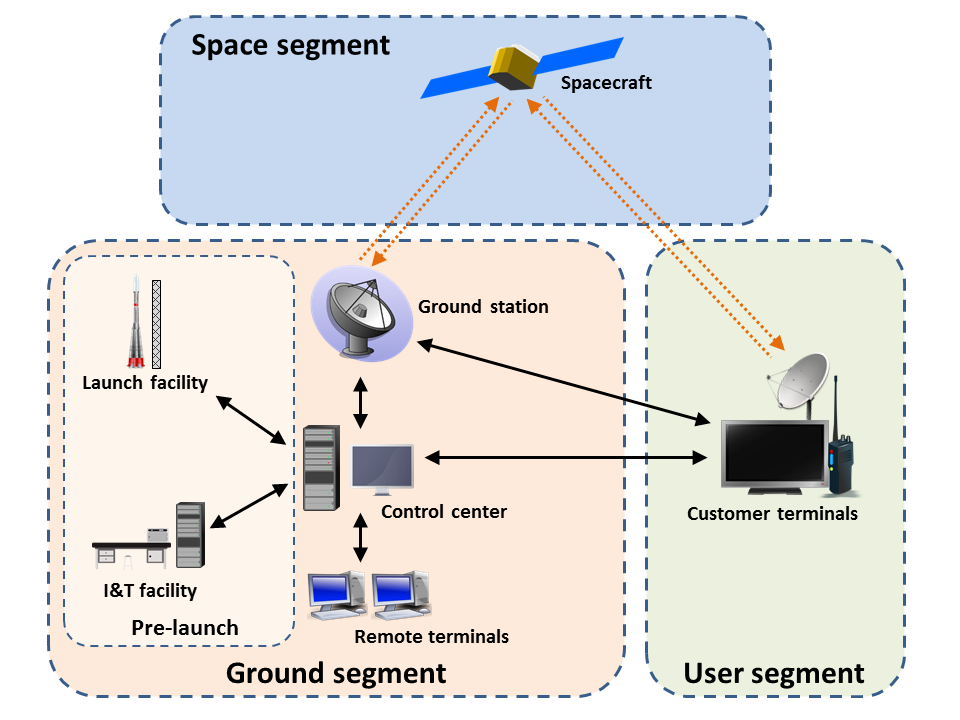|
Delfi-C3
Delfi-C3 is a CubeSat satellite constructed by students at the Delft University of Technology in the Netherlands. It is a 3-unit CubeSat, and was launched at 03:53:42 on 28 April 2008, as part of the NLS-4 mission, aboard a PSLV rocket, from the Second Launch Pad at the Satish Dhawan Space Centre in India. The launch was contracted by ISRO, through Antrix Corporation and UTIAS. The satellite's primary mission is technology demonstration and development. It is carrying new types of solar cells, a solar sensor for TNO Science and Industry, and a high-efficiency amateur radio transceiver experiment. Delfi-C3 does not contain batteries, as the experiments are dependent on the sun. She is the fourth Dutch Satellite, after ANS, IRAS and SLOSHSAT. It is the first Dutch university Satellite and is based on a 3-Unit CubeSat. Some other mission characteristics include: * No active attitude control * 1200Bd BPSK VHF downlink * Linear transponder The Delfi-C3 ground segment consi ... [...More Info...] [...Related Items...] OR: [Wikipedia] [Google] [Baidu] |
List Of CubeSats
The following is a list of CubeSats, nanosatellites used primarily by universities for research missions, typically in low Earth orbits. Some CubeSats became Timeline of first satellites by country, their country's first national satellite. The extensive Nanosatellite and CubeSat Database lists nearly 4,000 CubeSats and NanoSats have been launched since 1998. The organization forecasts that 2080 nanosats will launch within the next 6 years. Research and development * SBUDNIC was launched to test Arduino Nano and other commercial off-the-shelf technology in space, using a simple, open-source design. * An ambitious project is the QB50, an international network of 50 CubeSats for multi-point by different universities and other teams, ''in-situ'' measurements in the lower thermosphere (90–350 km) and re-entry research. QB50 is an initiative of the von Karman Institute and is funded by the European Union. Double-unit ("2-U") CubeSats (10x10x20 cm) are foreseen, with one unit (t ... [...More Info...] [...Related Items...] OR: [Wikipedia] [Google] [Baidu] |
Delft University Of Technology
The Delft University of Technology (TU Delft; ) is the oldest and largest Dutch public university, public Institute of technology, technical university, located in Delft, Netherlands. It specializes in engineering, technology, computing, design, and natural sciences. It is considered one of the leading technical universities in Europe and is consistently ranked as one of the best schools for architecture and engineering in the world. According to the QS World University Rankings it ranked 3rd worldwide for architecture and 13th for Engineering, Engineering & Technology in 2024. It also ranked 3rd best worldwide for Mechanical engineering, mechanical and aerospace engineering, 3rd for Civil engineering, civil and structural engineering, 11th for chemical engineering, and 12th for design. With eight Faculty (division), faculties and multiple research institutes, TU Delft educates around 27,000 students (undergraduate and postgraduate), and employs more than 3,500 doctoral candidates ... [...More Info...] [...Related Items...] OR: [Wikipedia] [Google] [Baidu] |
Nanosatellite Launch System
The Nanosatellite Launch System (NLS) is a series of satellite launch missions launched 2003–2010, coordinated by the Space Flight Laboratory (SFL) of the University of Toronto Institute for Aerospace Studies (UTIAS). NLS has provided low-cost launch services for a number of nanosatellites. Missions NLS 1 * Launch date: 30 June 2003 * Launch vehicle: Rockot * Launch site: Plesetsk Cosmodrome * Participants: CanX-1, AAUSAT-1, DTUsat NLS 4 * Launch date: 28 April 2008 * Launch vehicle: Polar Satellite Launch Vehicle (PSLV-C9) * Launch site: Satish Dhawan Space Centre, Second Launch Pad * Participants: CanX-2, AAUSAT-II, COMPASS-1, Delfi-C3, CUTE-1.7+APD II and SEEDS II NLS 5 * Launch date: 28 April 2008 * Launch vehicle: Polar Satellite Launch Vehicle (PSLV-C9) * Launch site: Satish Dhawan Space Centre, Second Launch Pad * Participants: CanX-6/NTS NLS 6 * Launch date : July 12, 2010 * Launch vehicle: Polar Satellite Launch Vehicle (PSLV-C15) * Laun ... [...More Info...] [...Related Items...] OR: [Wikipedia] [Google] [Baidu] |
IRAS
The Infrared Astronomical Satellite (Dutch language, Dutch: ''Infrarood Astronomische Satelliet'') (IRAS) was the first space telescope to perform a astronomical survey, survey of the entire night sky at infrared wavelengths. Launched on 25 January 1983, its mission lasted ten months. The telescope was a joint project of the United States (NASA), the Netherlands (Netherlands Agency for Aerospace Programmes, NIVR), and the United Kingdom (Science and Engineering Research Council, SERC). Over 250,000 infrared sources were observed at 12, 25, 60, and 100 micrometer wavelengths. Support for the processing and analysis of data from IRAS was contributed from the Infrared Processing and Analysis Center at the California Institute of Technology. Currently, the Infrared Science Archive at IPAC holds the IRAS archive. The success of IRAS led to interest in the 1985 STS-51-F, Infrared Telescope (IRT) mission on the Space Shuttle, and the planned Shuttle Infrared Telescope Facility whi ... [...More Info...] [...Related Items...] OR: [Wikipedia] [Google] [Baidu] |
Satellites Of The Netherlands
A satellite or an artificial satellite is an object, typically a spacecraft, placed into orbit around a celestial body. They have a variety of uses, including communication relay, weather forecasting, navigation (GPS), broadcasting, scientific research, and Earth observation. Additional military uses are reconnaissance, early warning, signals intelligence and, potentially, weapon delivery. Other satellites include the final rocket stages that place satellites in orbit and formerly useful satellites that later become defunct. Except for passive satellites, most satellites have an electricity generation system for equipment on board, such as solar panels or radioisotope thermoelectric generators (RTGs). Most satellites also have a method of communication to ground stations, called transponders. Many satellites use a standardized bus to save cost and work, the most popular of which are small CubeSats. Similar satellites can work together as groups, forming constellations. Becaus ... [...More Info...] [...Related Items...] OR: [Wikipedia] [Google] [Baidu] |
CubeSats
A CubeSat is a class of small satellite with a form factor of cubes. CubeSats have a mass of no more than per unit,, url=https://static1.squarespace.com/static/5418c831e4b0fa4ecac1bacd/t/5f24997b6deea10cc52bb016/1596234122437/CDS+REV14+2020-07-31+DRAFT.pdf , title=Cubesat Design Specification , publisher=California Polytechnic State University, San Luis Obispo, Cal Poly SLO , year=2020 , location=San Luis Obispo , pages=12 and often use commercial off-the-shelf (COTS) components for their electronics and structure. CubeSats are deployed into orbit from the International Space Station, or launched as secondary payloads on a launch vehicle. , more than 2,300 CubeSats have been launched. In 1999, California Polytechnic State University (Cal Poly) professor Jordi Puig-Suari and Bob Twiggs, a professor at Stanford University Space Systems Development Laboratory, developed the CubeSat specifications to promote and develop the skills necessary for the design, manufacture, and testing of ... [...More Info...] [...Related Items...] OR: [Wikipedia] [Google] [Baidu] |
Spacecraft Launched In 2008
A spacecraft is a vehicle that is designed to fly and operate in outer space. Spacecraft are used for a variety of purposes, including communications, Earth observation, meteorology, navigation, space colonization, planetary exploration, and transportation of humans and cargo. All spacecraft except single-stage-to-orbit vehicles cannot get into space on their own, and require a launch vehicle (carrier rocket). On a sub-orbital spaceflight, a space vehicle enters space and then returns to the surface without having gained sufficient energy or velocity to make a full Earth orbit. For orbital spaceflights, spacecraft enter closed orbits around the Earth or around other celestial bodies. Spacecraft used for human spaceflight carry people on board as crew or passengers from start or on orbit (space stations) only, whereas those used for robotic space missions operate either autonomously or telerobotically. Robotic spacecraft used to support scientific research are space pro ... [...More Info...] [...Related Items...] OR: [Wikipedia] [Google] [Baidu] |
Student Satellites
A student is a person enrolled in a school or other educational institution, or more generally, a person who takes a special interest in a subject. In the United Kingdom and most commonwealth countries, a "student" attends a secondary school or higher (e.g., college or university); those in primary or elementary schools are "pupils". Africa Nigeria In Nigeria, education is classified into four systems known as a 6-3-3-4 system of education. It implies six years in primary school, three years in junior secondary, three years in senior secondary and four years in the university. However, the number of years to be spent in university is mostly determined by the course of study. Some courses have longer study lengths than others. Those in primary school are often referred to as pupils. Those in university, as well as those in secondary school, are referred to as students. The Nigerian system of education also has other recognized categories like the polytechnics and colleges of ... [...More Info...] [...Related Items...] OR: [Wikipedia] [Google] [Baidu] |
Delfi-n3Xt
Delfi-n3Xt is a Dutch nanosatellite which is operated by Delft University of Technology. It was launched on 21 November 2013. It is a three-unit CubeSat A CubeSat is a class of small satellite with a form factor of cubes. CubeSats have a mass of no more than per unit,, url=https://static1.squarespace.com/static/5418c831e4b0fa4ecac1bacd/t/5f24997b6deea10cc52bb016/1596234122437/CDS+REV14+2020-07-3 ... which will be used to demonstrate propulsion and communications systems for future missions. Delfi-n3Xt was launched successfully by a Dnepr carrier rocket flying from Site 370/13 at the Dombarovsky launch site. Delfi was a secondary payload aboard the rocket, whose primary mission was to deploy DubaiSat 2 and STSAT-3. Delfi was one of 25 secondary payloads aboard the rocket, for a total of 32 satellites. The Delfi team made contact with the satellite during its first pass. References Student satellites Spacecraft launched in 2013 CubeSats Satellites of the Netherla ... [...More Info...] [...Related Items...] OR: [Wikipedia] [Google] [Baidu] |
Ground Segment
A ground segment consists of all the ground-based elements of a spaceflight, space system used by operators and support personnel, as opposed to the Satellite space segment, space segment and user segment. The ground segment enables management of a spacecraft, and distribution of Payload (computing), payload data and telemetry among interested parties on the ground. The primary elements of a ground segment are: * Ground station, Ground (or Earth) stations, which provide radio interfaces with spacecraft * Mission control center, Mission control (or operations) centers, from which spacecraft are managed * Remote terminal (telecommunication), terminals, used by support personnel * Spacecraft System integration testing, integration and test facilities * Spaceport, Launch facilities * Ground Telecommunications network, networks, which allow for communication between the other ground elements These elements are present in nearly all space missions, whether Commercial use of space, comm ... [...More Info...] [...Related Items...] OR: [Wikipedia] [Google] [Baidu] |
Linear Transponder
A communications satellite's transponder is the series of interconnected units that form a communications channel between the receiving and the transmitting antennas. It is mainly used in satellite communication to transfer the received signals. A transponder is typically composed of: * an input band-limiting device (an input band-pass filter), * an input low-noise amplifier (LNA), designed to amplify the signals received from the Earth station (normally very weak, because of the large distances involved), * a frequency translator (normally composed of an oscillator and a frequency mixer) used to convert the frequency of the received signal to the frequency required for the transmitted signal, * an output band-pass filter, * a power amplifier (this can be a traveling-wave tube or a solid-state amplifier). Most communication satellites are radio relay stations in orbit and carry dozens of transponders, each with a bandwidth of tens of megahertz. Most transponders operate on a ... [...More Info...] [...Related Items...] OR: [Wikipedia] [Google] [Baidu] |
BPSK
Phase-shift keying (PSK) is a digital modulation process which conveys data by changing (modulating) the phase of a constant frequency carrier wave. The modulation is accomplished by varying the sine and cosine inputs at a precise time. It is widely used for wireless LANs, RFID and Bluetooth communication. Any digital modulation scheme uses a finite number of distinct signals to represent digital data. PSK uses a finite number of phases, each assigned a unique pattern of binary digits. Usually, each phase encodes an equal number of bits. Each pattern of bits forms the symbol that is represented by the particular phase. The demodulator, which is designed specifically for the symbol-set used by the modulator, determines the phase of the received signal and maps it back to the symbol it represents, thus recovering the original data. This requires the receiver to be able to compare the phase of the received signal to a reference signal such a system is termed coherent (and referred ... [...More Info...] [...Related Items...] OR: [Wikipedia] [Google] [Baidu] |







